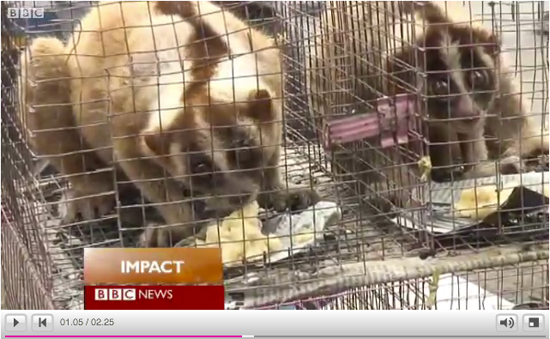
Illegal trafficking, trade, and poaching of endangered wildlife in Indonesia are not new problems, but these disgusting practices that blatantly violate animal rights and the law have been drawing more attention than usual in international media lately.
Although it gives me hope that more people are paying attention to this rampant problem and that new wildlife protection laws are getting enacted, I am very concerned that little is actually being done to improve this dire situation.
As Tracy McVeigh reports from the UK, Kalimantan (the Indonesian part of Borneo) has almost 10% of the world’s tropical forest and an extraordinary biodiversity that constantly multiplies with three new species being discovered there on average every month. It is the only home of some of the world’s most endangered mammals: the Bornean pygmy elephant, clouded leopard, sun bear and orangutan. All of them face extinction if the ancient forest is destroyed.
But there are other species, such as the wild banteng, pangolins, crocodiles, tigers, elephants and rhinos, that are less threatened by habitat loss than they are hunting, according to Erik Meijaard, who reported the following in the Jakarta Globe:
Hunting is happening inside and outside protected areas and enforcement of anti-hunting laws is nearly nonexistent. Only the anti-poaching teams for tiger and rhino protection seem to have had some success in catching poachers and getting them prosecuted. The rest of the hunting goes on largely unnoticed, uncontrolled and unpunished.
Indonesia does have laws against killing, trading or otherwise harming protected species, but apart from a handful of cases in which tiger and rhino poachers were jailed, no one has ever been effectively prosecuted for illegally killing protected wildlife in Indonesia.
A recent report by the wildlife trade organization Traffic suggested that more than 1,000 orangutans are killed or captured each year in Kalimantan for the wildlife trade alone. Recent surveys by the Nature Conservancy and the Indonesian Association of Primatologists (Perhappi) suggest that this figure may be an underestimate, and that many more orangutans are killed simply for local consumption.
I find it very hard to believe that Indonesia is famed for its wildlife biodiversity and yet the illegal catching, caging and selling of its wildlife continues widely unregulated. Watch this heart-wrenching video filmed on an average day in a Jakarta market to get a sense of the scope of the problem:
And things are not much different for Indonesia’s northern neighbor.
Last week Malaysia passed into law a new Wildlife Conservation Act, which on one hand should be applauded, but on the other it was received with much caution and skepticism as enforcement remains to be seen. The root of this deep-seated concern: Corruption.
Throughout 2010, the Department of Wildlife and National Parks, called Perhilitan, was repeatedly named and shamed in the world’s press, including National Geographic magazine, for “covering up widespread corruption, being incompetent, careless, unprofessional and uncaring about wildlife and unworthy of any respect.” Sean Whyte of Nature Alert has been an outspoken advocate on the issue for years and continues pressuring the Convention on International Trade in Endangered Species of Wild Fauna and Flora (CITES) for miserably failing to systematically monitor or report international wildlife trade in South East Asia, with an emphasis on orangutans.
Most CITES-listed species occur in countries where governance is often weak and corruption high.
In addition to orangutans, tigers are protected from international commercial trade through the CITES Appendix I listing, yet tiger numbers are falling alarmingly and efforts to save this magnificent animal have unfortunately not yet lead to a reverse in the decline in tiger populations.
As Malaysian President Sahabat Alam Malaysia (SAM) welcomed in the new Wildlife Protection Act, others scoffed at the legislation, deeming it mired in bureaucratic procrastination:
Unfortunately most cases of wildlife crime end in acquittal either because the procedures are not followed meticulously or the documents are riddled with loopholes.
Cases of wildlife smuggling should be treated like those in narcotics crime and punishment based on the quantum of seizures to help curb smuggling.
It is time to fight wildlife crime effectively, and collective actions must be taken to stop the key drivers that are bringing tigers and other endangered species to the brink of extinction: poaching, smuggling and illegal trade.
